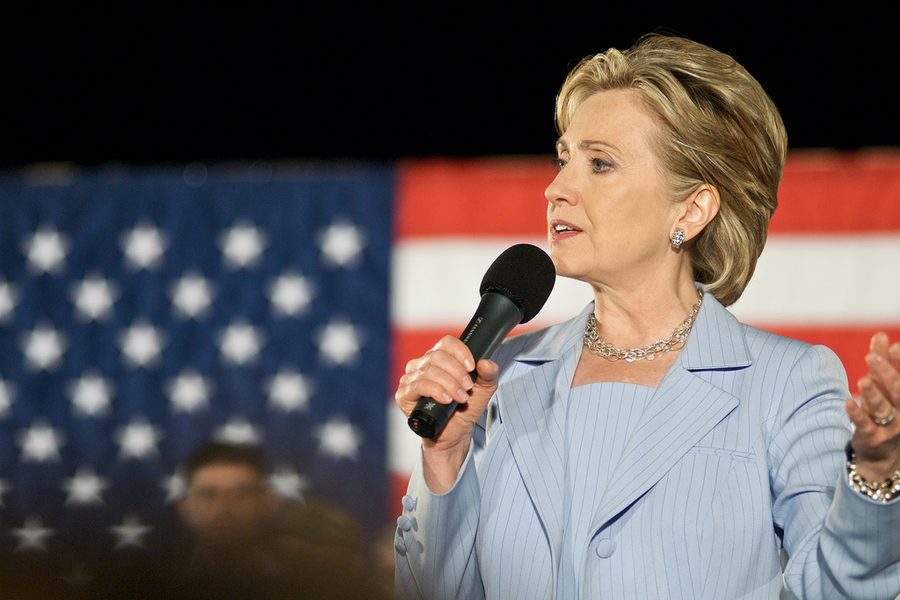Robert Reich: Why Hillary Clinton Is Wrong for Refusing To Resurrect Glass-Steagall
Resurrection of the Glass-Steagall Act has become an important policy difference between Hillary Clinton and Bernie Sanders.
Robert Reich

This post first appeared at RobertReich.org.
Hillary Clinton won’t propose reinstating a bank break-up law known as the Glass-Steagall Act – at least according to Alan Blinder, an economist who has been advising Clinton’s campaign. “You’re not going to see Glass-Steagall,” Blinder said after her economic speech Monday in which she failed to mention it. Blinder said he had spoken to Clinton directly about Glass-Steagall.
This is a big mistake.
It’s a mistake politically because people who believe Hillary Clinton is still too close to Wall Street will not be reassured by her position on Glass-Steagall. Many will recall that her husband led the way to repealing Glass Steagall in 1999 at the request of the big Wall Street banks.
It’s a big mistake economically because the repeal of Glass-Steagall led directly to the 2008 Wall Street crash, and without it we’re in danger of another one.
Some background: During the Roaring Twenties, so much money could be made by speculating on shares of stock that several big Wall Street banks began selling stock along side their traditional banking services – taking in deposits and making loans.
Some banks went further, lending to pools of speculators that used the money to pump up share prices. The banks sold the shares to their customers, only to have the share prices collapse when the speculators dumped them.
For the banks, it was an egregious but hugely profitable conflict of interest.
After the entire stock market crashed in 1929, ushering in the Great Depression, Washington needed to restore the public’s faith in the banking system. One step was for Congress to enact legislation insuring commercial deposits against bank losses.
Another was to prevent the kinds of conflicts of interest that resulted in such losses, and which had fueled the boom and subsequent bust. Under the Glass-Steagall Act of 1933, banks couldn’t both gamble in the market and also take in deposits and make loans. They’d have to choose between the two.
“The idea is pretty simple behind this one,” Senator Elizabeth Warren said a few days ago, explaining her bill to resurrect Glass-Steagall. “If banks want to engage in high-risk trading — they can go for it, but they can’t get access to ensured deposits and put the taxpayers on the hook for that reason.”
For more than six decades after 1933, Glass-Steagall worked exactly as it was intended to. During that long interval few banks failed and no financial panic endangered the banking system.
But the big Wall Street banks weren’t content. They wanted bigger profits. They thought they could make far more money by gambling with commercial deposits. So they set out to whittle down Glass-Steagall.
Finally, in 1999, President Bill Clinton struck a deal with Republican Senator Phil Gramm to do exactly what Wall Street wanted, and repeal Glass-Steagall altogether.
What happened next? An almost exact replay of the Roaring Twenties. Once again, banks originated fraudulent loans and sold them to their customers in the form of securities. Once again, there was a huge conflict of interest that finally resulted in a banking crisis.
This time the banks were bailed out, but millions of Americans lost their savings, their jobs, even their homes.
A personal note. I worked for Bill Clinton as Secretary of Labor and I believe most of his economic policies were sound. But during those years I was in fairly continuous battle with some other of his advisers who seemed determined to do Wall Street’s bidding.
On Glass-Steagall, they clearly won.
To this day some Wall Street apologists argue Glass-Steagall wouldn’t have prevented the 2008 crisis because the real culprits were nonbanks like Lehman Brothers and Bear Stearns.
Baloney. These nonbanks got their funding from the big banks in the form of lines of credit, mortgages, and repurchase agreements. If the big banks hadn’t provided them the money, the nonbanks wouldn’t have got into trouble.
And why were the banks able to give them easy credit on bad collateral? Because Glass-Steagall was gone.
Other apologists for the Street blame the crisis on unscrupulous mortgage brokers.
Surely mortgage brokers do share some of the responsibility. But here again, the big banks were accessories and enablers.
The mortgage brokers couldn’t have funded the mortgage loans if the banks hadn’t bought them. And the big banks couldn’t have bought them if Glass-Steagall were still in place.
I’ve also heard bank executives claim there’s no reason to resurrect Glass-Steagall because none of the big banks actually failed.
This is like arguing lifeguards are no longer necessary at beaches where no one has drowned. It ignores the fact that the big banks were bailed out. If the government hadn’t thrown them lifelines, many would have gone under.
Remember? Their balance sheets were full of junky paper, non-performing loans, and worthless derivatives. They were bailed out because they were too big to fail. And the reason for resurrecting Glass-Steagall is we don’t want to go through that ever again.
As George Santayana famously quipped, those who cannot remember the past are condemned to repeat it. In the roaring 2000’s, just as in the Roaring Twenties, America’s big banks used insured deposits to underwrite their gambling in private securities, and then dump the securities on their customers.
It ended badly.
This is precisely what the Glass-Steagall Act was designed to prevent – and did prevent for more than six decades.
Hillary Clinton, of all people, should remember.
Robert B. Reich, Chancellor’s Professor of Public Policy at the University of California at Berkeley, was Secretary of Labor in the Clinton administration. Time magazine named him one of the ten most effective cabinet secretaries of the 20th century. He has written numerous books, including the bestsellers Aftershock and The Work of Nations. His latest is titled The System: Who Rigged It, How We Fix It.







